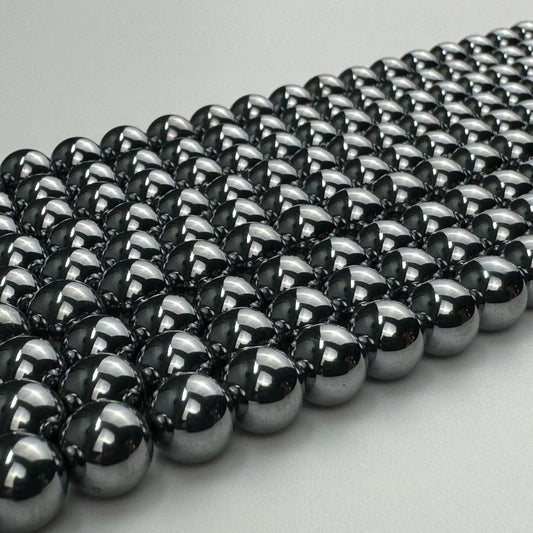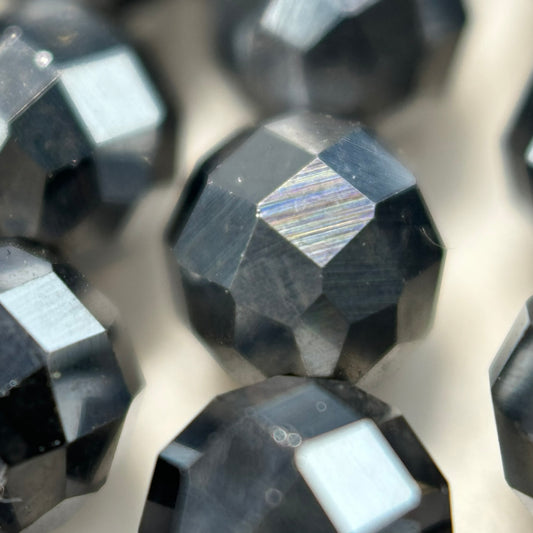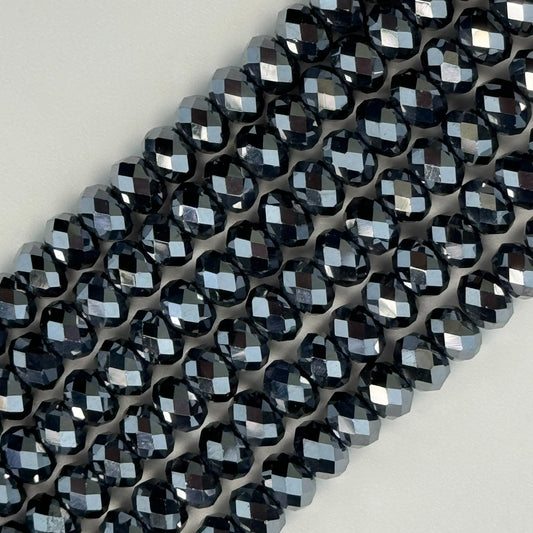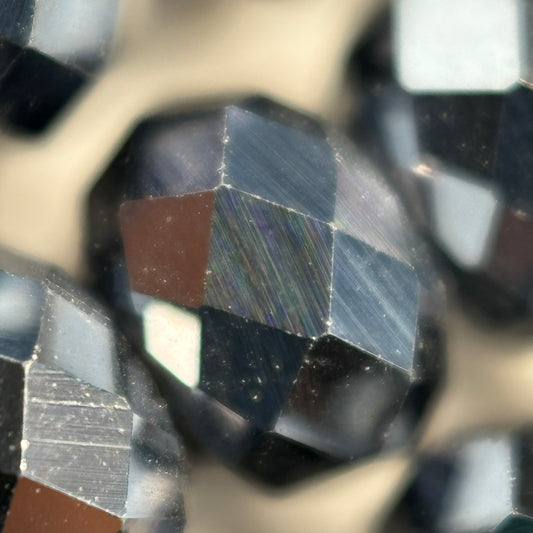Terahertz Gemstone Beads
Understanding Terahertz Gemstone Beads
Terahertz is a synthetic crystal material engineered to resonate at terahertz frequencies, which are electromagnetic waves between microwave and infrared radiation. This modern material combines scientific innovation with aesthetic appeal for unique jewelry applications.
Distinctive Features
- Synthetic crystal material
- Engineered for specific frequencies
- Modern technological creation
- Mohs hardness of 6.5-7
- Unique visual properties
Composition and Manufacturing
Terahertz consists primarily of silicon dioxide (SiO2) with additional elements added during manufacturing to create its distinctive properties and appearance.
Manufacturing Process
- Base material: Silicon dioxide
- Additional elements added
- Controlled crystal growth
- Frequency-specific engineering
- Precision manufacturing
Optical Properties and Appearance
Terahertz displays unique optical properties resulting from its engineered structure. The material may show various colors and visual effects.
Visual Characteristics
- Various color possibilities
- Unique optical effects
- Engineered appearance
- Consistent quality
- Modern aesthetic
Frequency Resonance Properties
Terahertz's primary characteristic is its resonance at terahertz frequencies. This property is the basis for its name and intended applications.
Frequency Characteristics
- Terahertz frequency range
- Electromagnetic wave resonance
- Between microwave and infrared
- Specific frequency engineering
- Scientific applications
Cutting and Processing
Terahertz can be cut and processed using standard lapidary techniques. The material's hardness allows for various cutting styles.
Processing Methods
- Faceted cuts possible
- Cabochon cuts work well
- Bead shapes achievable
- Good polish quality
- Various shapes possible
Hardness and Durability
With a Mohs hardness of 6.5-7, Terahertz offers good durability for jewelry use, similar to many natural gemstones.
Durability Factors
- Mohs hardness: 6.5-7
- Good resistance to scratching
- Stable under normal conditions
- Suitable for jewelry
- Consistent properties
Care and Maintenance Guidelines
Terahertz requires standard gemstone care practices. The material is stable and easy to maintain.
Care Instructions
- Clean with warm soapy water
- Soft cloth for drying
- Store separately
- Standard jewelry care
- Protect from impacts
Jewelry Design Applications
Terahertz beads create unique, modern jewelry pieces. The material's engineered nature appeals to those seeking contemporary designs.
Design Uses
- Modern jewelry designs
- Contemporary aesthetics
- Unique statement pieces
- Technology-inspired designs
- Futuristic styles
Scientific and Technological Context
Terahertz technology has various scientific and industrial applications. The gemstone material represents this technology in jewelry form.
Technological Context
- Terahertz wave applications
- Scientific research uses
- Industrial applications
- Medical imaging potential
- Security scanning uses
Comparison with Natural Gemstones
Terahertz differs from natural gemstones in its synthetic origin and engineered properties. Understanding this distinction is important.
Distinguishing Features
- Synthetic vs. natural origin
- Engineered properties
- Consistent quality
- Modern creation
- Scientific basis
Value and Collectibility
Terahertz's value comes from its unique nature and manufacturing process rather than geological rarity like natural gemstones.
Value Factors
- Manufacturing quality
- Unique appearance
- Modern appeal
- Consistent properties
- Technology interest
Metaphysical Associations
Terahertz holds significance in various metaphysical traditions, associated with frequency healing and energy work.
Symbolic Meanings
- Frequency healing
- Energy alignment
- Modern spirituality
- Technology and consciousness
- Frequency resonance
Ethical and Environmental Considerations
As a synthetic material, Terahertz raises different ethical considerations than natural gemstones, including manufacturing processes and environmental impact.
Considerations
- Synthetic origin
- Manufacturing processes
- Environmental impact
- No mining required
- Controlled production
Frequently Asked Questions
What is the mineral composition of Terahertz gemstone beads?
Terahertz is a synthetic crystal material composed primarily of silicon dioxide (SiO2) with additional elements that create its distinctive properties. It's engineered to resonate at terahertz frequencies, which are electromagnetic waves between microwave and infrared radiation.
What is the Mohs hardness rating of Terahertz beads?
Terahertz beads typically have a Mohs hardness of 6.5 to 7, making them suitable for jewelry use. This hardness level provides good durability for everyday wear while requiring reasonable care to prevent scratches from harder materials.
What causes the unique optical properties of Terahertz gemstone beads?
Terahertz's unique optical properties result from its engineered crystal structure, which allows it to interact with terahertz frequency electromagnetic waves. The material may exhibit distinctive color shifts, translucency, or iridescent effects depending on its composition and manufacturing process.
What is the difference between Terahertz and natural quartz gemstones?
While both contain silicon dioxide, Terahertz is a synthetic, engineered material designed for specific electromagnetic properties, whereas natural quartz forms through geological processes. Terahertz is created in controlled laboratory conditions to achieve consistent properties, while natural quartz varies based on formation conditions.
What are the primary sources and manufacturing process of Terahertz gemstone?
Terahertz is manufactured in specialized laboratories using advanced crystal growth techniques. The material is synthesized rather than mined, allowing for precise control over its properties. Production involves high-temperature processes and controlled cooling to achieve the desired crystal structure.
How does the crystal structure of Terahertz affect its cutting and drilling?
Terahertz's engineered crystal structure requires careful handling during cutting and drilling. The material should be cut with diamond tools, and drilling must be done slowly with adequate cooling to prevent thermal stress fractures. The crystal orientation may affect the final appearance of the beads.
What is the specific gravity and refractive index of Terahertz?
Terahertz typically has a specific gravity ranging from 2.60 to 2.70, similar to natural quartz. The refractive index is approximately 1.54-1.55, which contributes to its optical properties and helps distinguish it from other materials.
Can Terahertz beads be heat treated or enhanced?
Terahertz is already an engineered material, so additional heat treatment is generally not necessary or recommended, as it may alter the carefully controlled crystal structure. The material is designed to maintain its properties under normal conditions.
What causes the color variations in Terahertz gemstone beads?
Color variations in Terahertz result from differences in the manufacturing process, including the specific elements added during synthesis, crystal growth conditions, and any intentional modifications to achieve desired optical effects. Different production batches may show slight variations.
How should Terahertz beads be stored to prevent damage?
Store Terahertz beads separately from harder gemstones to prevent scratching. Avoid exposure to extreme temperatures, as thermal shock can cause fracturing. Keep them in a soft pouch or lined jewelry box away from direct sunlight and harsh chemicals.
What is the crystal system and optical behavior of Terahertz?
Terahertz typically forms in a hexagonal or trigonal crystal system, similar to quartz. Its optical behavior is engineered to interact with terahertz frequency radiation, which may result in unique visual effects not seen in natural gemstones.
How does the quality of Terahertz beads affect their value?
High-quality Terahertz beads feature uniform color distribution, consistent crystal structure, good translucency, minimal inclusions or fractures, and precise cutting. The consistency of the engineered material and the quality of the finishing work significantly impact value.
What are the optical properties that make Terahertz suitable for jewelry?
Terahertz's combination of good hardness (6.5-7 on Mohs scale), unique optical properties, engineered consistency, and distinctive appearance make it suitable for jewelry. The material offers a modern, scientific aesthetic that appeals to those interested in advanced materials.
How can you identify genuine Terahertz beads from other materials?
Genuine Terahertz will have consistent properties typical of engineered materials, including uniform structure, specific gravity around 2.60-2.70, and refractive index of approximately 1.54-1.55. The material should show the characteristic properties for which it was engineered, and may come with documentation of its synthetic origin.
What is the relationship between Terahertz and frequency resonance properties?
Terahertz is engineered to resonate at terahertz frequencies (between 0.1 and 10 THz), which are electromagnetic waves between microwave and infrared radiation. This property is the material's defining characteristic, though it may not be visually apparent in finished beads.





